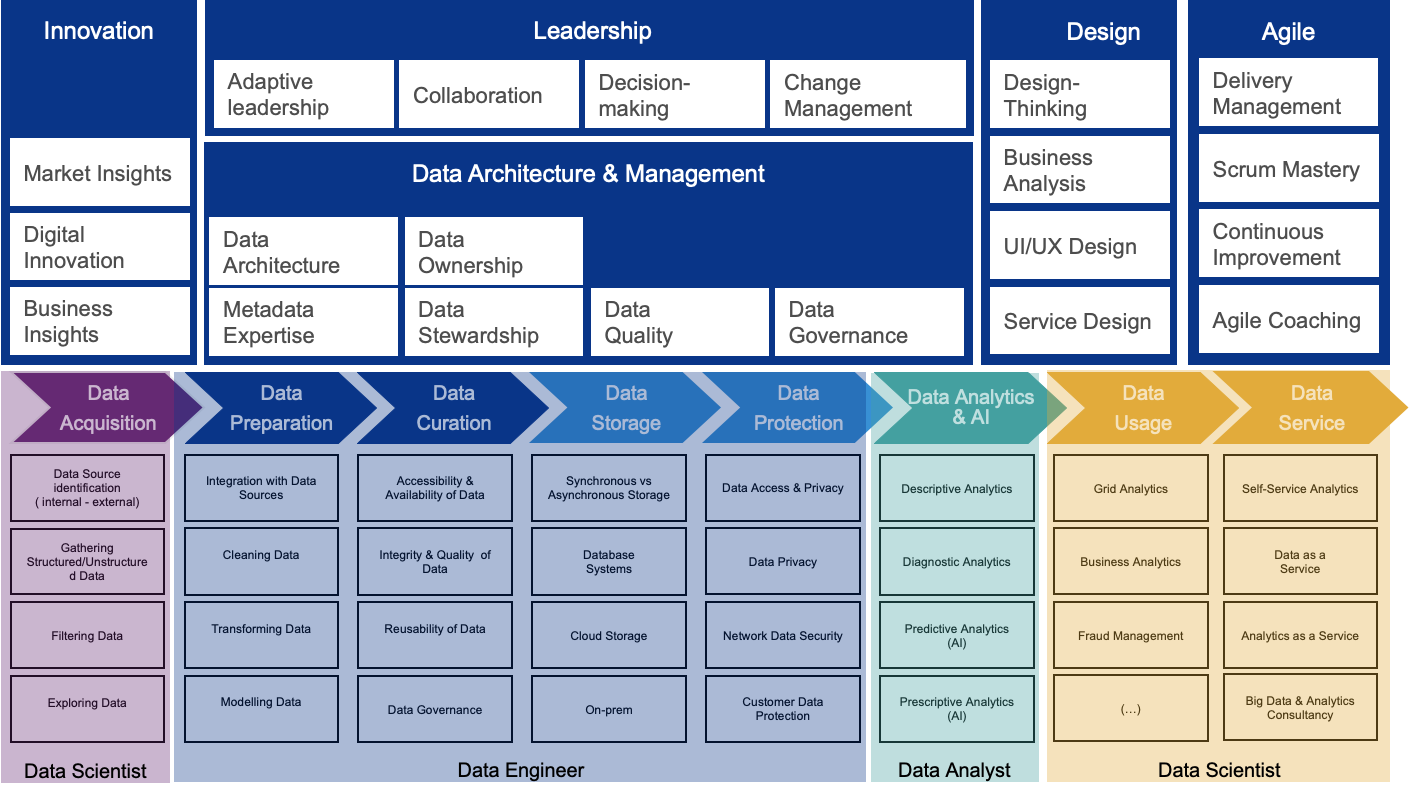Creating an AI Center of Excellence (AI CoE) is a strategic approach to embrace the ai journey and capitalize on the potential of artificial intelligence within your organization. It provides a centralized platform for managing AI initiatives, developing AI talent, and overseeing the implementation of AI technologies.
Here, I’ll explore establishing governance processes that align operations with stakeholders and ensure data ownership across business units. Furthermore, I’ll discuss implementing agile delivery models and developing sector-specific competencies. I’ll also emphasize centralizing technology for efficient use by promoting data-driven solutions and establishing clear system ownership. Adapting existing analytics and BI platforms to accommodate automated machine learning tools will be another key focus area.
Last but not least, mastering data management policies by developing master data management strategies and defining target operation platforms form a crucial part of setting up an effective AI CoE. Stay tuned as we unfold these essential steps in detail throughout our discussion on how to setup an AI Center of Excellence.
Setup an AI Center of Excellence
First, Let’s start with a potential setup plan for your AI CoE:
Phase 1: Current state assessment, around 10-12 weeks
- Assess data sources, maps, and flows within your business and the ability to centralize those to take ownership of their operation.
- Assess your agile maturity to identify pain points impacting agile delivery of CoE services from Governance, Org. Structure, Process, Culture, Leadership, Human Centric Design.
- Assess the adaptation of the existing Analytics and BI platform and define your requirements in this regard to deploying a Big Data & Data Analytics solution.
- Define required skills and sourcing options (e.g., build in-house, managed service…)
Phase 2: Target Mode of Operation, around 8-12 weeks
- Define a clear vision and long-term Data and AI roadmap
- Develop the data architecture of your organization
- Develop the data governance framework (Ownership and RACI) in alignment with the security units
- Define a roadmap to adopt digital capabilities and mindset within your organization (e.g., AI, ML, design thinking)
- Develop the Master Data Management Policies
- Develop a delivery blueprint to adopt your “New Way of Working,” including IT and business alignment.
- Define the target operation platforms (e.g., Data lake, DWH, Cloud, Dashboards…)
Phase 3: Setup the AI Center of Excellence
The COE shall be operated by Data Science Experts
The capabilities for 36 Months
- Set up a team of data architects and data scientists to operate the CoE and build the capabilities within your organization.
Now, let’s get into more detail about how to set up an AI CoE….
CoE AI Vision
Developing a clear vision for the integration of AI within our company is crucial. Executives should engage in discussions, preferably with AI experts, to gain an understanding of what AI truly entails, its capabilities, and how it can potentially unlock new business models and strategies. Neglecting this important step may result in underutilizing the full potential that AI has to offer for our organization.
 Example: A comprehensive set of competencies are required to properly operate the CoE
Example: A comprehensive set of competencies are required to properly operate the CoE
Governance
In a nutshell, establishing Governance and Processes in the AI Center of Excellence ensures smooth sailing for your AI CoE.
The first step in setting up an AI Center of Excellence (CoE) is to establish a solid governance process. that includes:
- Ownership of the data architecture and data platforms
- Alignment of the operation and governance with stakeholders
- Orchestrate clear ownership of data and analytics processes across business units
- Ensure executive and business accountability for digital capabilities through digital campaigning and awareness sessions
- Identify and establish agile delivery models applicable and tailored to your business (DevOps, Scrum, Kanban, CICD, eSafe…) to enable the fast adoption of analytics and AI
- Getting Everyone on the Same Page by aligning operations with stakeholders ensures that everyone knows what they’re doing and works towards common goals. It’s like a team huddle before the big game.
- Clear Data Ownership, No Confusion through defining data ownership across business units avoids any “Who’s responsible for this?” confusion.
Competence
Mastering the Art of AI starts with developing sector-specific competencies, and it’s the key to know how to Setup an AI Center of Excellence. It starts with:
- Appoint a chief information officer and establish ethics-related positions.
- Build sector-specific competencies (e.g. Electricity, Telecom, finance,…) on the data Scientist level to be positioned with specific background and business development mindset.
- Ensure sufficient onboarding and training.
- Showcase benefits for your business to quantify investment in the adoption of digital technologies (AI, ML, design thinking, etc.).
- Adopting agile delivery models to keep your business competitive in the digital world.
- Establish dedicated organizational units.
- Define primary organizational reporting line.
- Establish ethics-related positions.
- Monitor created centralized ai oversight groups.
- Avoid excessive bureaucracy

Establishing and nurturing a network of AI advocates is crucial for the success of an AI CoE. To maximize its potential, the center should cultivate influential supporters who champion the technology throughout the organization. This stage has already been advanced in many companies, as indicated by a Deloitte survey which found that 45% of companies had assigned senior executives as AI champions across various departments. With programming becoming more accessible through readily available scripts in languages like R and Python, it is advisable to focus on developing expertise in statistical and mathematical modeling rather than pure programming when building in-house capabilities.
“Set up an AI Center of Excellence with solid governance, aligned stakeholders, clear data ownership, agile delivery, and industry-specific mastery. #AI #DigitalTransformation” Click to Tweet
Technology
- Centralize data, analytics and AI tools and architecture
- Ensure efficient usage of existing tools and quality for reliable data across business units
- Avoid creating silos resulting in sourcing data from different systems
- Establish ownership of data responsibility at the system and root level
- Promote data-driven solutions for your business, such as Cognitive bots, Finance Risk Evaluation, IoT telematics solutions, smart grid and intelligent assets, and AI-based lighthouse projects to showcase quick wins
- Turn data into a valuable business asset and competitive advantage using relevant data management and models for preventive maintenance and customer satisfaction
Centralizing Technology for Maximum Efficiency
Do you desire to have your business running smoothly? Centralize all your data, analytics, and AI tools under one roof. It’s like having a superhero team of technology working together to save the day.
One Owner to Rule Them All
Every system or tool needs a designated owner. It’s like having a powerful guardian with a cape on hand to swoop in and salvage the situation when troubles arise. They’ll manage access, troubleshoot issues, and keep everything running smoothly.
This centralized approach streamlines operations, improves communication, and avoids those awkward “who has access to what” moments. Plus, it keeps your customer data safe.
In summary (but we’re not done yet), centralizing technology isn’t just efficient; it’s the foundation for your AI Center of Excellence. So, suit up and get ready to conquer the tech world.
Adapting Existing Analytics and Current Systems
Before diving into new technologies, take a moment to see if your current analytics and BI platforms can handle the AI integration wave. It may be time to switch up your tech if it can’t keep pace with the latest trends. Check out some tips on evaluating system capabilities here.
Creating a Long-Term Roadmap for Implementation
Don’t focus solely on the present. Develop a clear vision and a long-term roadmap for Data & AI implementation.
- Defining Goals: Figure out what you want to achieve with Data and AI. Maybe you want to impress customers or make your operations super efficient. Goals are like the GPS for your strategy.
- Milestones: Break down your journey into manageable stages.
- Resource Allocation: Make sure you have enough people and money to make your dreams come true.
- Risk Management: Prepare for possible roadblocks and challenges. It’s like having a backup plan and an alternative solution in case of unforeseen issues.
To learn more about creating effective digital transformation strategies, check out this comprehensive guide from McKinsey Digital. Remember: an adaptable platform and a solid plan are the keys to AI excellence.
Define Target Operation Platforms
Aside from creating solid data management policies, you also need to choose the right operational platforms. Consider factors like scalability needs, cost considerations, and specific requirements for processing power or memory capacity.
You can go for cloud-based solutions like Amazon SageMaker, Microsoft AI Stack, or Google Cloud AI Platform. If you’re feeling adventurous, try open-source frameworks like TensorFlow or PyTorch. Choose the best option based on your particular business requirements, considering both advantages and disadvantages.
Conclusion
In conclusion, setting up an AI Center of Excellence requires a strategic approach to governance and process, centralizing technology for efficient use, adapting existing analytics & BI platforms, and mastering data management policies.
Aligning operations with stakeholders and ensuring data ownership across business units is necessary for success.
Implementing agile delivery models is like doing a high-speed juggling act, but it keeps the AI initiatives on track.
Developing sector-specific competencies gives organizations an edge in the AI game.
Centralizing technology promotes the use of data-driven solutions and clear system root-level ownership.
Adapting existing analytics & BI platforms involves assessing their adaptation capabilities and creating a long-term roadmap.
Mastering data management policies ensures the effective utilization of AI technologies.
So, buckle up and get ready for the exciting journey of establishing an AI Center of Excellence!





